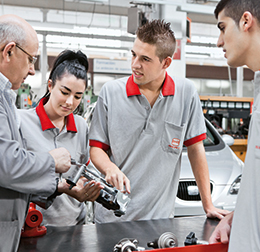“Doing something yourself is motivating”, agree Débora, Iván and Javier. They are among the first trainees in Spain to benefit from the introduction of the dual system of vocational training and education at SEAT. The combination of theory and practice has many advantages – and not just for the young people in the company.

EACH STEP, EACH TURN HAS TO BE
PERFECT – Iván Vendrell breakdances
regularly with friends. He applies the same
passion and commitment to his hobby as to
his vocational training as a motor vehicle
mechatronics technician at SEAT.
“Although I know in theory how robotic welding works, I only really understood it here on the shop floor.”
DÉBORA OCAÑA,
TRAINEE IN SEAT’S DUAL SYSTEM

Iván Vendrell quickly crosses the workshop at the SEAT vocational school in Martorell. He is off to meet Javier Sánchez. The two have arranged to go to class together. In the hall next door, Débora Ocaña stands in front of the machine tool she has just programmed, tracking the machine’s movements and making notes. “Perfect. Exactly how I wanted it to work.” The spark in her eyes shows just how pleased she is. You only need to watch Débora, Iván and Javier on this completely ordinary Wednesday morning to see the pleasure and passion they bring to their work. They are proud to be learning their trade at SEAT.
This applies in particular to 16-year-old Iván, who is training to be a motor vehicle mechatronics technician. He is one of the first young people to have started a German-style dual vocational traineeship at SEAT. The carmaker is the first major company in Spain to have introduced this successful model, which combines theory and plenty of practice. In the past, the standard three-year vocational traineeship at SEAT included 600 hours of practical instruction. Now, training involves 1,700 hours of work at the company. This allows Iván and the other trainees to gain experience in their future careers at an early stage.
SEAT’s new program also gives trainees more time to try things out – and that is motivating. Electronics technician trainee Débora is fascinated by the technology involved in automobile production today. She likes to tinker and wants to know exactly how everything works. “Although I know in theory how robotic welding works, I only really understood it here on the shop floor.”
Iván, too, is most at home in the workshop. He proudly points out the small metal stairs he milled in the third week of his traineeship. They are a testament to the meticulousness and dedication with which Iván is preparing for his career. He approaches his second great passion – breakdancing – in the same way. Each step, each turn has to be perfect. He regularly meets friends after work to learn new moves and styles.
Many of his friends wish they had a traineeship like Iván’s. Spain has the second-highest youth unemployment rate in Europe. The Spanish government is supporting the new training model by allowing the vocational trainees to be integrated into business operations. This was previously not possible – students at vocational schools could only gain on-the-job experience in the form of internships. Today, SEAT’s vocational trainees create special parts for models, for example.
For SEAT and the Volkswagen Group, sound qualifications are first and foremost an investment in competitiveness. That is why the carmaker is exporting the dual vocational training and education system to all of its locations around the world – China, India and the USA will join the twelve European countries that have already rolled out the program. At SEAT in Spain, a total of 146 young people started their traineeship under the new program in fall 2012.
146
YOUNG PEOPLE are currently undertaking dual vocational training at SEAT
1,700
HOURS of hands-on experience in the company are included in the three-year curriculum
For Débora and Javier, memories of their first exciting days as trainees are not quite as fresh. Débora – a confident 21-year-old – is already in her second traineeship year and about to start work on the plant’s production line. Since she is slightly nervous about her first hands-on deployment, she is glad to have the guidance and support of a mentor, like all trainees at SEAT.

OUT AND ABOUT WITH FRIENDS IN BARCELONA’S OLD CITY – Javier Sánchez is training to become an industrial and tools mechanic. SEAT is his future. “We learn faster because we specialize earlier than other trainees – that is an unbeatable advantage in the working world.”
19-year-old Javier values the extra time the new training program gives him with the automated milling machine. He will complete his traineeship as an industrial and tools mechanic this year. He sometimes gives going out with friends in Barcelona’s old town a miss for the chance to learn more. SEAT is his future. “We learn faster because we specialize earlier than other trainees – that is an unbeatable advantage in the working world.”
The smart young man brings with him technical experience from home. His father runs a small machine shop and taught him how to handle tools as a boy. These days, though, it is Javier giving his father tips and talking shop with him about tool quality – and sometimes even helping out in purchasing. Thanks to his vocational trainee’s salary he can contribute to the family budget. The introduction of the dual training and education system also saw the adoption of a graduated pay scale, as is common in Germany. That is another first in Spain.
SEAT plans to offer all vocational trainees who successfully complete the program a permanent position with the company. “The dual vocational training and education system is a real boon for us. The close link between theory and hands-on practice ensures that our future employees have a high level of expertise”, says Manuel Moreno, who is responsible for training and vocational education at SEAT Human Resources. But it’s not just SEAT that benefits – qualified vocational training for its young people ultimately also strengthens Spain’s industry as a whole.
PHOTOGRAPHER Andreas Mader
ADDITIONAL INFORMATION www.seat.com









